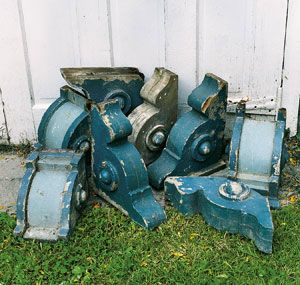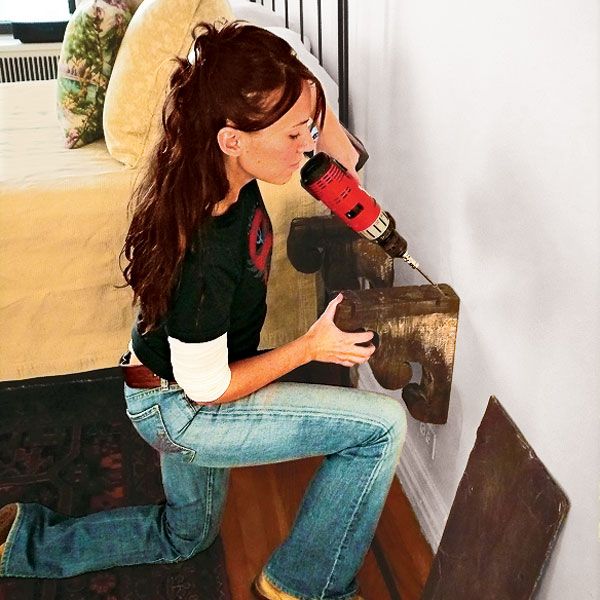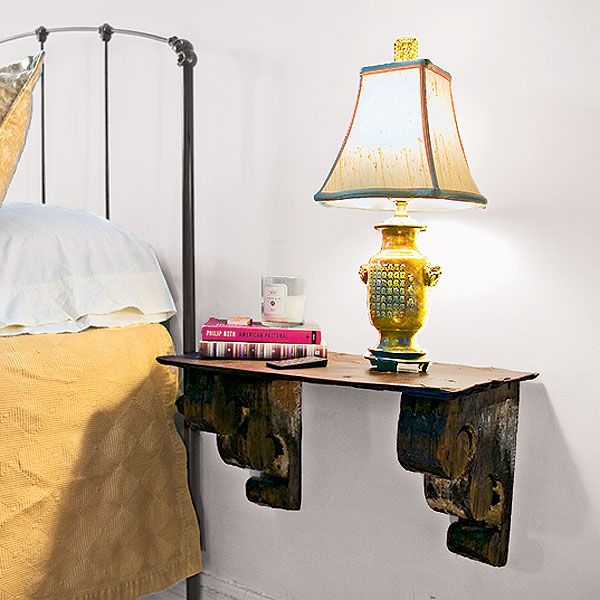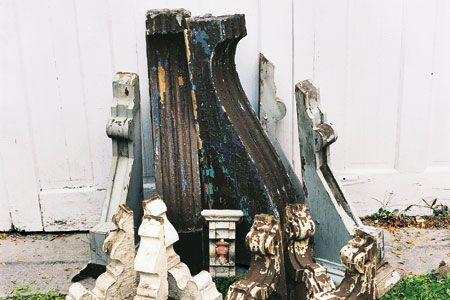Corbels are decorative brackets that have adorned buildings for centuries, adding structural support and charm. These architectural elements have evolved from their medieval origins to become versatile design features in modern homes. In this guide, we’ll explain the different purposes and types of corbels throughout history.
The Purpose of Corbels
Corbels serve dual purposes in architecture, adding strength and personality to the inside or outside of your home.
Structural Support
At their core, corbels are load-bearing elements. They’re designed to transfer the weight of protruding architectural features, such as balconies, roof eaves, or shelves, to the main structure of the building. This support allows for overhanging elements without compromising the building’s integrity.
Decorative Elements
Beyond their practical function, corbels are dynamic and give character to both exterior and interior spaces. They can transform a plain surface into an eye-catching feature. As influential tastemaker A.J. Downing wrote in his book The Architecture of Country Houses, using trim “boldly” and for reasons “beyond mere utility” can greatly add to a home’s picturesque character.

Types of Corbels in Residential Architecture
Different architectural styles use corbels, each reflecting the particular designs of their era.
Victorian-Era Corbels
Victorian homes are known for their ornate details, and corbels played a significant role in this decorative scheme. By the 1890s, mass-produced corbels were readily available through catalogs, offering a wide variety of designs. These ranged from solid serpentine and quarter-round forms to more elaborate shapes with applied droplet details and intricate scrollwork. Victorian corbels could be as short as 4 inches or as long as 3 feet, allowing for versatile applications across the facade. You’ll still see these corbels in many Victorian homes today.
Tudor-Style Corbels
Tudor-style houses, influenced by English medieval architecture, incorporated corbels as a nod to their historical roots. These corbels typically featured simpler designs compared to their Victorian counterparts, emphasizing clean lines and sharp angles that highlighted strength over ornament.
Craftsman Bungalow Corbels
In the early 1900s, Craftsman bungalows embraced corbels as an architectural feature. Consistent with the Craftsman ethos, these corbels featured clean lines and emphasized functionality. They were often used to support roof overhangs and porch roofs, contributing to the style’s characteristic look of sturdy, rustic, handcrafted construction.
Materials Used in Corbel Construction
The choice of material for corbels has varied over time and across regions, with each material offering unique properties and aesthetic qualities.
Stone Corbels
Stone was the material of choice for corbels in medieval European architecture. Durable and capable of supporting significant weight, stone corbels were often intricately carved to depict various figures and scenes. While less common in modern residential architecture, stone corbels are still used in high-end construction and restoration projects for their timeless appeal and strength.
Wooden Corbels
In America, wood became the preferred material for corbels due to its abundance and ease of carving. Wooden corbels could be crafted into intricate designs more easily than stone, allowing for greater artistic expression. Various types of wood were used, each with different grain patterns and durability. Today, wooden corbels remain popular for both exterior and interior applications, prized for their warmth and versatility.
Metal Corbels
Metal corbels, although less traditional, have gained popularity in contemporary architecture. These corbels are often made from wrought or cast iron and can be designed with intricate scrollwork or sleek, modern lines. Metal corbels are highly durable and can provide a unique contrast when paired with other materials in home design. They are particularly popular in industrial or minimalist-style homes for their robustness and distinctive look.
How To Identify Authentic Vintage Corbels
Identifying authentic vintage corbels requires a keen eye for detail and an understanding of historical construction methods. Look for signs of hand craftsmanship, such as slight irregularities in carving or evidence of old tools. Authentic wooden corbels from the 19th and early 20th centuries will likely show signs of age, including a patina on the wood, and wear consistent with their age and use. The style and motifs of the corbel should also align with the architectural period it’s supposedly from.
Modern Applications of Corbels in Home Design
While corbels are less commonly used in new construction, they’ve evolved to be used for other creative projects.
Interior Design Ideas
Inside the home, corbels have found new life as decorative elements. They can be used to do the following:
- Support kitchen countertop overhangs
- Brace open shelving in living rooms or kitchens
- Frame doorways or archways
- Embellish fireplace mantels
- Create unique wall-mounted display areas
These projects allow homeowners to add a touch of architectural history into modern interiors, blending form and function in imaginative ways.

DIY Projects Using Salvaged Corbels
Salvaged corbels can be repurposed into unique home decor items, adding charm to your living spaces.
Wall-Mounted Bedside Table
One idea is to convert a pair of vintage corbels into a functional and stylish bedside table. Here’s how:
- Locate a wall stud using a stud finder or by tapping the wall.
- Position one corbel on the stud at your desired height and mark its top edge.
- Use a level to extend this line for the second corbel.
- Drill pilot holes through the top of each corbel at a 45-degree angle.
- Secure the corbels to the wall with 3-inch screws.
- Place a piece of slate or wood on top of the corbels to create the tabletop.
- Secure the tabletop with adhesive-backed Velcro tape for easy removal.

Decorative Shelf Brackets
Following a similar process as the one above for a wall-mounted bedside table, you can turn corbels into decorative shelf brackets in any room in your home. Think floating bookshelves, dishware displays, or a space for showcasing art.
Corbel Console Table
Another idea is to create a corbel console table for your entryway or living room. To do it yourself, try the following:
- Find a pair of large vintage corbels that work for the vibe you’re looking for.
- Choose a sturdy piece of wood or glass as the tabletop.
- Attach the corbels to the wall using heavy-duty brackets.
- Secure the tabletop to the corbels with appropriate fasteners.
This will turn something ordinary into a statement piece, combining historical charm with practicality.
Where To Find Vintage and Reproduction Corbels
For those wanting to use corbels in their home design, there are several sources to explore:
- Architectural salvage yards
- Antique shops and flea markets
- Custom millwork shops for reproductions
- Home improvement stores for modern interpretations
- Online marketplaces specializing in architectural elements
When sourcing vintage corbels, consider their condition and whether they’ll be used for decorative purposes only or need to provide structural support.
Maintaining and Restoring Antique Corbels
Treat antique corbels with care to preserve their beauty and integrity. For wooden corbels, regular cleaning and occasional refinishing can help protect them from the elements. If a corbel needs to be restored, it’s often best to talk with a professional who specializes in architectural preservation to ensure its historical value is kept intact.
Cleaning Tips
To clean antique corbels, use a soft brush to remove dust and debris without damaging the surface. For more thorough cleaning, use a mild, oil-free soap and water solution. Avoid harsh chemicals that could strip away the original finish or cause wood to swell.
Restoration Techniques
Restoring corbels often involves repairing cracks or chips in the material. Fill small cracks with wood filler and sand it smooth before applying a stain or paint that matches the original finish. For more extensive damage, work with a professional craftsman who can accurately replicate the missing elements and keep their structural integrity.
Difference Between Corbels, Cantilevers, and Cornices
While often confused, corbels, cantilevers, and cornices serve different architectural purposes:
- Corbels are decorative brackets that provide support from below.
- Cantilevers are structural elements that project horizontally from a wall, supported only on one end.
- Cornices are horizontal decorative moldings that crown a building at the roof or wall.
Our Conclusion
Corbels are a fascinating blend of form and function in architectural design. Whether used externally to support roof overhangs or internally as creative shelf brackets, corbels continue to find relevance in contemporary architecture and interior design.

